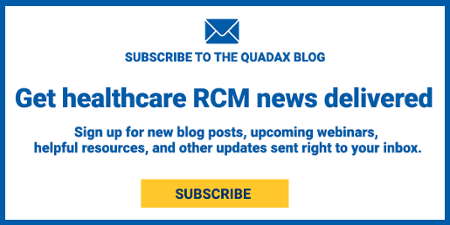Discover the top trends in healthcare revenue cycle management for 2025, including AI, RPA, data analytics, blockchain, and patient engagement strategies.
As we enter 2025, healthcare's evolving landscape demands innovative revenue cycle management (RCM) solutions. While automation continues to address staffing shortages and manual tasks, AI and predictive analytics are gaining traction, particularly in denial prevention, to streamline processes, enhance efficiency, and ultimately improve patient outcomes.
According to a survey, the Healthcare IT Market will grow to $390.7 billion by the end of 2024. Processing 30 billion healthcare transactions is expected annually which will cost approximately $250 billion and by the end of this year (2024), healthcare spending in the United States will reach approximately $5.4 trillion.Here are some of the top trends shaping healthcare revenue cycle management:
1. Artificial Intelligence (AI) and Machine Learning (ML):
- Predictive Analytics: AI-powered algorithms can analyze vast datasets to predict potential denials, identify high-risk accounts, and forecast revenue streams. This proactive approach allows providers to intervene early and minimize financial losses. Prediction of denials, time-to-payment, and many more insights allow for adjustments to billing and workflows and to project cash flow at any given time–all of which helps to further optimize your revenue cycle strategy to support growth and operational goals.
- Machine Learning: By analyzing historical revenue cycle data, ML algorithms will help predict future trends, patient payment patterns, and reasons for revenue leakage. This capability empowers providers to optimize strategies, improve reimbursements, and make informed financial decisions.
- Automation: AI and ML can automate repetitive tasks such as data entry, eligibility verification, and prior authorization requests. This frees up valuable staff time for more complex and strategic activities.
-
Denial Management: AI’s role in RCM is becoming increasingly pivotal. A recent KLAS report stated that “more than 90% of denials stem from front-end problems such as eligibility verification, prior authorizations, and documentation errors.” Eighty-two percent of chief financial officers say payer denials have increased significantly since pre-pandemic levels, and nearly two-thirds of healthcare organizations plan to increase spending on AI in the next three years. In 2025, AI is expected to significantly aid in managing denials. By identifying patterns in denied claims, AI enables healthcare providers to develop effective appeal strategies, thus optimizing the denial management process.
2. Robotic Process Automation (RPA):
- Streamlined Processes: RPA software can automate rule-based tasks, such as data entry, claims submission, and payment posting. This reduces manual errors, improves accuracy, and accelerates the revenue cycle.
- Cost Savings: By automating routine tasks, RPA can significantly reduce labor costs and improve overall operational efficiency.
- Enhanced Compliance: RPA can help ensure compliance with regulatory requirements, such as HIPAA, by automating data security and privacy measures.
3. Data Analytics
- Utilizing Actionable Data: Deep-diving into data plays a critical role in RCM by identifying trends, patterns, and outliers to enhance efficiency and effectiveness. This tool helps in pinpointing root causes of denials, allowing for targeted interventions.
4. Blockchain Technology:
- Enhanced Security and Transparency: Blockchain technology can improve the security and transparency of healthcare transactions, reducing the risk of fraud and ensuring accurate and timely payments.
- Improved Interoperability: Blockchain can facilitate seamless data exchange between different healthcare providers and payers, improving interoperability and reducing administrative burdens.
5. Patient Engagement:
- Patient Portals: Online portals empower patients to access their results, schedule appointments, and make payments, improving communication and satisfaction.
- Printed Statements: Despite the rise of digital solutions, printed and mailed billing statements continue to play a significant role in patient engagement, especially with the older demographic. By offering a mix of traditional and digital options, healthcare providers can cater to diverse patient preferences, ensuring that all patients feel supported and informed. As technology continues to evolve, so will the methods of engaging with patients, promising a more efficient and patient-centric future.
6. Regulatory Oversight Changes
- FDA and LDT Final Rule: The LDT final rule, which regulates laboratories as device manufacturers and LDTs as devices, took effect on July 5, 2024 and laboratories should plan to comply with the Stage 1 requirements by May 6, 2025. However, should pending lawsuits filed against the FDA by ACLA and AMP prevail, the new administration could be prompted to change the current course of the LDT regulation. Read more in our blog with guest author Christine Bump.
7. Workforce Shortages and New Staffing Models
- Staff recruitment and retention: These are critical pain points as many organizations struggle to maintain an engaged workforce amid increasing workloads. Artificial Intelligence (AI) and Predictive Intelligence (PI) are increasingly seen as transformative tools in addressing these challenges. Automating repetitive revenue cycle tasks, like claim status checks and payment posting, is a powerful way to cut labor costs and boost productivity. And, PI uses historical data to ensure proactive planning balances workloads, reduces overtime and burnout, and helps control labor costs for a healthier bottom line.
While financial pressures continue to impact healthcare organizations, these emerging trends present exciting opportunities for improvement. By leveraging these technologies and strategies, providers can navigate the challenges and build a more robust and efficient revenue cycle
When you partner with Quadax, you can overcome these challenges with ease. Harness the power of our comprehensive suite of revenue cycle management and clearinghouse services to streamline your processes and boost your financial standing. Discover how Quadax can empower you to achieve success by scheduling a strategy call today!


